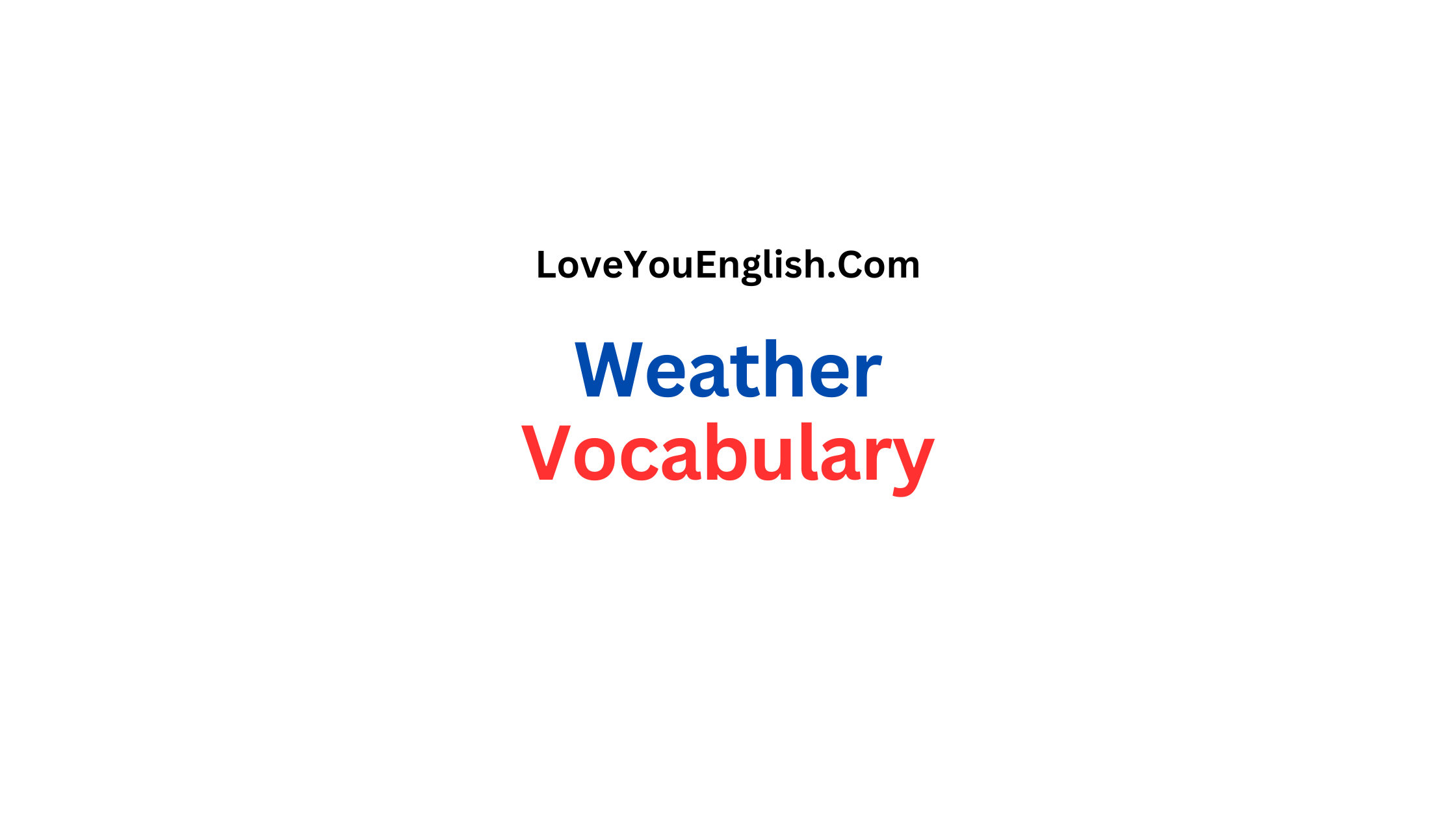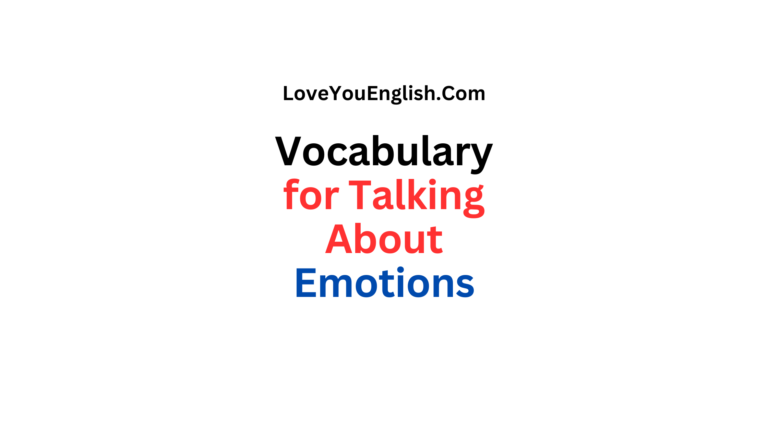Expand English Vocabulary: Weather Words
Weather is a part of our daily lives.
It affects what we wear, our plans, and even our moods. But sometimes, the words used to describe weather can be confusing.
I will help you understand common weather terms, so you can make sense of forecasts and talk about the weather with confidence.
Temperature
Temperature is how hot or cold it is outside.
It’s usually measured in degrees Fahrenheit (°F) in the United States, and degrees Celsius (°C) in most other countries.
- Hot: When it’s very warm outside, usually above 85°F (29°C).
- Warm: Pleasant, mild heat, typically between 70-85°F (21-29°C).
- Cool: Slightly cold, usually between 50-60°F (10-15°C).
- Cold: When it feels chilly, typically below 50°F (10°C).
- Freezing: At or below 32°F (0°C), when water turns to ice.
Precipitation
Precipitation is any form of water that falls from the sky.
- Rain: Water droplets that fall from clouds.
- Drizzle: Very light rain with tiny droplets.
- Downpour: Heavy rain that falls quickly.
- Sleet: A mix of rain and snow or ice pellets.
- Snow: Soft, white ice crystals that fall in flakes.
- Hail: Small balls of ice that fall during storms.
Cloud Types
Clouds are made of tiny water droplets or ice crystals floating in the air.
- Cumulus: Puffy, white clouds with flat bottoms.
- Stratus: Low, gray clouds that cover the whole sky.
- Cirrus: Thin, wispy clouds high in the sky.
- Nimbus: Dark rain clouds.
Wind
Wind is moving air. It can be gentle or very strong.
- Breeze: A light, gentle wind.
- Gust: A sudden, strong burst of wind.
- Gale: Very strong, constant wind.
- Hurricane/Typhoon: An extremely powerful storm with very strong winds.
Humidity
Humidity is the amount of water vapor in the air.
- Humid: When the air feels damp and sticky.
- Dry: When there’s very little moisture in the air.
- Muggy: Hot and very humid weather that feels uncomfortable.
Visibility
Visibility is how far you can see clearly.
- Fog: Tiny water droplets in the air that make it hard to see.
- Mist: Very light fog.
- Haze: When the air looks slightly unclear, often due to pollution.
- Clear: When you can see far into the distance.
Severe Weather
Severe weather includes dangerous conditions that can cause damage or harm.
- Thunderstorm: A storm with lightning, thunder, and often heavy rain.
- Lightning: A bright flash of electricity in the sky during a storm.
- Thunder: The loud sound that follows lightning.
- Tornado: A powerful, spinning column of air that touches the ground.
- Blizzard: A severe snowstorm with strong winds and low visibility.
- Drought: A long period with very little or no rain.
- Flood: When water covers normally dry land.
Seasonal Terms
These words describe weather patterns that happen during certain times of the year.
- Monsoon: A season with heavy rainfall, common in tropical areas.
- El Niño: A weather pattern that can cause unusual temperatures and rainfall around the world.
- Indian Summer: A period of warm weather in autumn, after it’s been cool.
- Arctic Blast: A sudden rush of very cold air from the north.
More vocabulary:
- English Vocabulary: 40 Public Services & Community Words
- 40 Words Related to Traditions and Customs, With Meanings
- 40 Literature & Books Related Words and their Meanings
- Expand Vocabulary: 40 Adventure & Exploration English Words
Weather Instruments
These tools help meteorologists (weather scientists) measure and predict the weather.
- Thermometer: Measures temperature.
- Barometer: Measures air pressure.
- Anemometer: Measures wind speed.
- Rain Gauge: Measures how much rain has fallen.
- Weathervane: Shows which direction the wind is blowing.
- Radar: Uses radio waves to detect rain, snow, and storms.
Weather Forecasting Terms
These words are often used when predicting future weather.
- Forecast: A prediction of future weather conditions.
- Front: The boundary between two different air masses.
- High Pressure: An area where air is sinking, often bringing clear skies.
- Low Pressure: An area where air is rising, often bringing clouds and rain.
- Jet Stream: A narrow band of strong winds high in the atmosphere that influences weather patterns.
Understanding the Forecast
Now that I’ve covered some basic weather terms, let’s look at how to understand a typical weather forecast:
“Tomorrow will be partly cloudy with a high of 75°F (24°C) and a low of 60°F (16°C). There’s a 30% chance of afternoon showers. Winds will be light from the southwest.”
Let’s break this down:
- “Partly cloudy” means there will be some clouds, but also some clear sky.
- The “high” is the warmest temperature expected during the day.
- The “low” is the coolest temperature, usually at night.
- “30% chance of showers” means there’s a 3 in 10 possibility of rain.
- “Light winds from the southwest” tells you it will be a bit breezy, with air moving from the southwest to the northeast.
Weather and Climate
It’s important to understand the difference between weather and climate:
- Weather is the day-to-day state of the atmosphere. It can change quickly.
- Climate is the average weather conditions in an area over a long period, usually 30 years or more.
For example, a place might have a rainy day (weather) but have a dry climate overall.
Extreme Weather Events
Sometimes, weather can become dangerous. Here are some extreme weather events to be aware of:
Hurricanes
Hurricanes are large, powerful storms that form over warm ocean waters.
They have very strong winds and can cause a lot of damage.
Hurricanes are called typhoons in the western Pacific Ocean and cyclones in the Indian Ocean.
Hurricane categories (based on wind speed):
- Category 1: 74-95 mph (119-153 km/h)
- Category 2: 96-110 mph (154-177 km/h)
- Category 3: 111-129 mph (178-208 km/h)
- Category 4: 130-156 mph (209-251 km/h)
- Category 5: 157 mph (252 km/h) or higher
Tornadoes
Tornadoes are spinning columns of air that reach from a storm cloud to the ground.
The strength of tornadoes is measured on the Enhanced Fujita (EF) Scale, from EF0 (weakest) to EF5 (strongest).
Blizzards
Blizzards are severe winter storms with strong winds and heavy snow.
They can make it very hard to see and travel.
Heat Waves
A heat wave is a period of unusually hot weather that lasts for several days or more.
Heat waves can be dangerous, especially for older people and young children.
Cold Snaps
A cold snap is a sudden period of very cold weather.
Like heat waves, cold snaps can be dangerous if people aren’t prepared.
Weather and Your Daily Life
Understanding weather terms can help you in many ways:
Planning outdoor activities:
Knowing the forecast can help you decide whether to have a picnic or stay indoors.
Dressing appropriately:
If you know it will be cold and rainy, you can wear warm clothes and bring an umbrella.
Staying safe:
Being aware of severe weather warnings can help you prepare and stay out of danger.
Gardening:
Knowing when to expect frost or hot weather can help you protect your plants.
Weather forecasts can help you plan trips and avoid delays.
Energy use:
Knowing the weather can help you decide when to use air conditioning or heating.
Weather Sayings and Their Meanings
Many cultures have sayings about weather.
Some are based on observation, while others are just for fun.
Here are a few common ones:
“Red sky at night, sailor’s delight. Red sky in morning, sailor’s warning.”
This saying suggests that a red sky at sunset often means good weather the next day, while a red sky at sunrise might mean bad weather is coming.
“April showers bring May flowers.”
This means that the rain in April helps flowers grow in May.
“It’s raining cats and dogs.”
This just means it’s raining very heavily. No actual cats or dogs are involved!
“Once in a blue moon.”
A blue moon is the second full moon in a calendar month, which doesn’t happen often.
This phrase means something happens very rarely.
Climate Change and Weather
You may have heard about climate change in the news.
Climate change refers to long-term changes in temperature, precipitation, wind patterns, and other measures of climate.
These changes can affect weather patterns, making some types of extreme weather more common.
Some effects of climate change on weather include:
- More frequent and intense heat waves
- Changes in rainfall patterns, leading to more droughts in some areas and more floods in others
- More powerful hurricanes
- Rising sea levels, which can make coastal flooding worse
Understanding weather terms can help you make sense of these changes and how they might affect your local area.
Conclusion
Weather is super interesting and plays a big role in our lives.
When you learn these weather words, you can understand forecasts better, get ready for different weather, and even wow your friends with what you know!
Just keep in mind that the weather is always shifting, so check the forecast and be prepared for whatever surprises come from Mother Nature.
Whether it’s bright and sunny, raining cats and dogs, or something else, you now have the words to discuss it.
So, the next time someone asks, “What’s the weather like?” you’ll have lots to share!








